Ditapis dengan
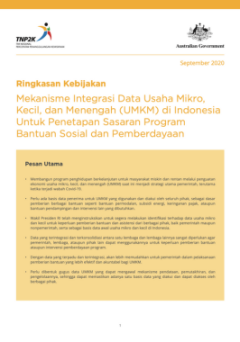
Ringkasan Kebijakan Mekanisme Integrasi Data Usaha Mikro, Kecil, dan Menengah…
The most optimal implementation target is equal to the Village Fund formulation that upholds the principles of equality and fairness. It is, therefore, necessary to develop a composite index prior to the distribution of allocations during fiscal year 2019. The composite index should also reflect the region’s condition, as is the case with the Village Fund with the development of the IKG. This…
- Edisi
- 1
- ISBN/ISSN
- -
- Deskripsi Fisik
- PDF, 12 Halaman
- Judul Seri
- Policy Brief
- No. Panggil
- 352.93 HAN.R
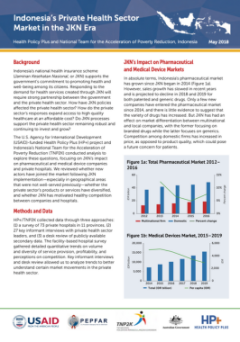
Indonesia’s Private Health Sector Market in the JKN Era
Indonesia’s national health insurance scheme (Jaminan Kesehatan Nasional, or JKN) supports the government’s commitment to promoting health and well-being among its citizens. Responding to the demand for health services created through JKN will require strong partnership between the government and the private health sector. How have JKN policies affected the private health sector? How do the…
- Edisi
- 1
- ISBN/ISSN
- -
- Deskripsi Fisik
- PDF, 2 Halaman
- Judul Seri
- Policy Brief
- No. Panggil
- 338.47 TNP. I
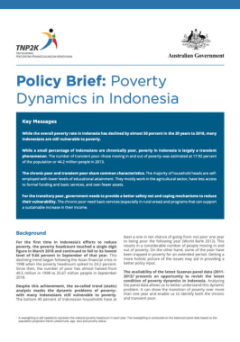
Policy Brief: Poverty Dynamics in Indonesia
While a small percentage of Indonesians are chronically poor, poverty in Indonesia is largely a transient phenomenon. The number of transient poor–those moving in and out of poverty–was estimated at 17.92 percent of the population or 44.2 million people in 2013
- Edisi
- 1
- ISBN/ISSN
- -
- Deskripsi Fisik
- PDF, 6 Halaman
- Judul Seri
- Policy Brief
- No. Panggil
- 362.5 FEB.P
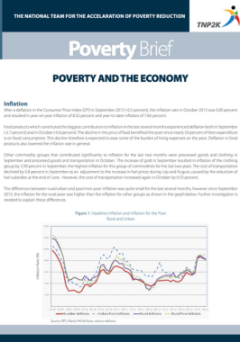
Poverty Brief Poverty And The Economy November 2013
After a deflation in the Consumer Price Index (CPI) in September 2013 (-0.3 percent), the inflation rate in October 2013 was 0.09 percent and resulted in year-on-year inflation of 8.32 percent and year-to-date inflation of 7.66 percent. Food products which constituted the biggest contribution to inflation in the last several months experienced deflation both in September (-2.7 percent) and i…
- Edisi
- -
- ISBN/ISSN
- -
- Deskripsi Fisik
- PDF, 4 Halaman
- Judul Seri
- Policy Brief
- No. Panggil
- 362.5 TNP.P
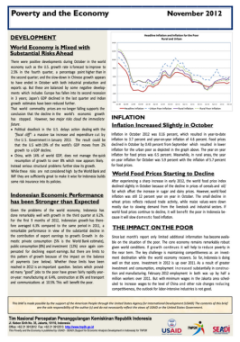
Poverty and the Economy November 2012
There were positive developments during October in the world economy such as the U.S. growth rate is forecast to improve to 2.5% in the fourth quarter, a percentage point higher than in the second quarter; and the slow-down in Chinese growth appears to have ended in October with both industrial producion and exports up. But these are balanced by some negaive developments which includes Europe h…
- Edisi
- 1
- ISBN/ISSN
- -
- Deskripsi Fisik
- PDF, 2 Halaman
- Judul Seri
- Policy Brief
- No. Panggil
- 362.5 USA.P
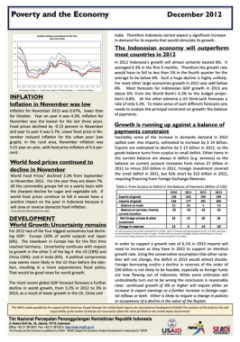
Poverty and the Economy December 2012
Inflation for November 2012 was 0.07%, lower than for October. Year on year it was 4.3%. InflaƟon for November was the lowest for the last three years. Food prices declined by ‐0.13 percent in November and year to year it was 5.7%. Lower food price in No‐ vember reduced inflaƟon for the urban poor (see graph). In the rural area, November inflaƟon was 5.01 year on year, with food pric…
- Edisi
- 1
- ISBN/ISSN
- -
- Deskripsi Fisik
- PDF, 2 Halaman
- Judul Seri
- Policy Brief
- No. Panggil
- 362.5 USA.P
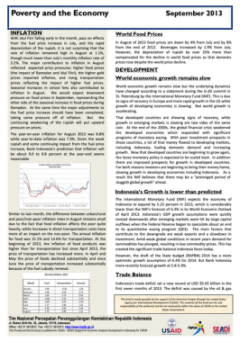
Poverty and the Economy September 2013
With Idul Fitri falling early in the month, pass on effects from the fuel price increase in July, and the rapid depreciation of the rupiah, it is not surprising that the rate of inflation remained high in August at 1.1%, though much lower than July’s monthly inflation rate of 3.2%. The major contributors to inflation in August reflected expected price pressures: higher food prices (the impact…
- Edisi
- 1
- ISBN/ISSN
- -
- Deskripsi Fisik
- PDF, 2 Halaman
- Judul Seri
- Policy Brief
- No. Panggil
- 362.5 USA.P
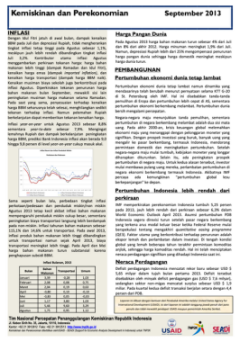
Kemiskinan dan Perekonomian September 2013
Dengan Idul Fitri jatuh di awal bulan, dampak kenaikan BBM pada Juli dan depresiasi Rupiah, tidak mengherankan tingkat inflasi tetap tinggi pada Agustus sebesar 1,1%, meskipun jauh lebih rendah dibandingkan tingkat inflasi Juli 3,2%. Kontributor utama inflasi Agustus menggambarkan perkiraan tekanan harga: harga bahan makanan lebih tinggi (dampak Ramadan dan Idul Fitri), kenaikan harga emas (dam…
- Edisi
- -
- ISBN/ISSN
- -
- Deskripsi Fisik
- PDF, 2 Halaman
- Judul Seri
- Policy Brief
- No. Panggil
- 362.5 USA.K
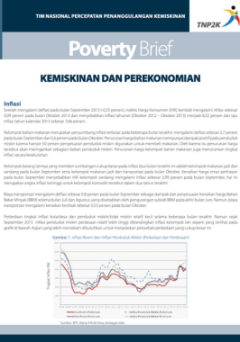
Poverty Brief Kemiskinan Dan Perekonomian
Kelompok bahan makanan merupakan penyumbang inflasi terbesar pada beberapa bulan terakhir, mengalami deflasi sebesar 2,7 persen pada bulan September dan 0,6 persen pada bulan Oktober. Penurunan harga bahan makanan mempunyai dampak positif pada penduduk miskin karena hampir 50 persen pengeluaran penduduk miskin digunakan untuk membeli makanan. Oleh karena itu penurunan harga tersebut akan mer…
- Edisi
- 1
- ISBN/ISSN
- -
- Deskripsi Fisik
- PDF, 2 Halaman
- Judul Seri
- Policy Brief
- No. Panggil
- 362.5 USA.P

Poverty and the Economy May 2013
The Headline CPI for April 2013 compared to March showed deflation of -0.1%. It partially corrected for the unusually high inflation of 0.6% in March 2013. However, the more meaningful year-on-year inflation for April was a fairly high, 5.6% higher than 2012 (4.5%) but lower than 2011 (6.2%). The government inflation target of 4.9% in 2013 will be difficult to achieve because year-to-date infla…
- Edisi
- 1
- ISBN/ISSN
- -
- Deskripsi Fisik
- PDF, 2 Halaman
- Judul Seri
- Policy Brief
- No. Panggil
- 362.5 USA.P
 Karya Umum
Karya Umum  Filsafat
Filsafat  Agama
Agama  Ilmu-ilmu Sosial
Ilmu-ilmu Sosial  Bahasa
Bahasa  Ilmu-ilmu Murni
Ilmu-ilmu Murni  Ilmu-ilmu Terapan
Ilmu-ilmu Terapan  Kesenian, Hiburan, dan Olahraga
Kesenian, Hiburan, dan Olahraga  Kesusastraan
Kesusastraan  Geografi dan Sejarah
Geografi dan Sejarah